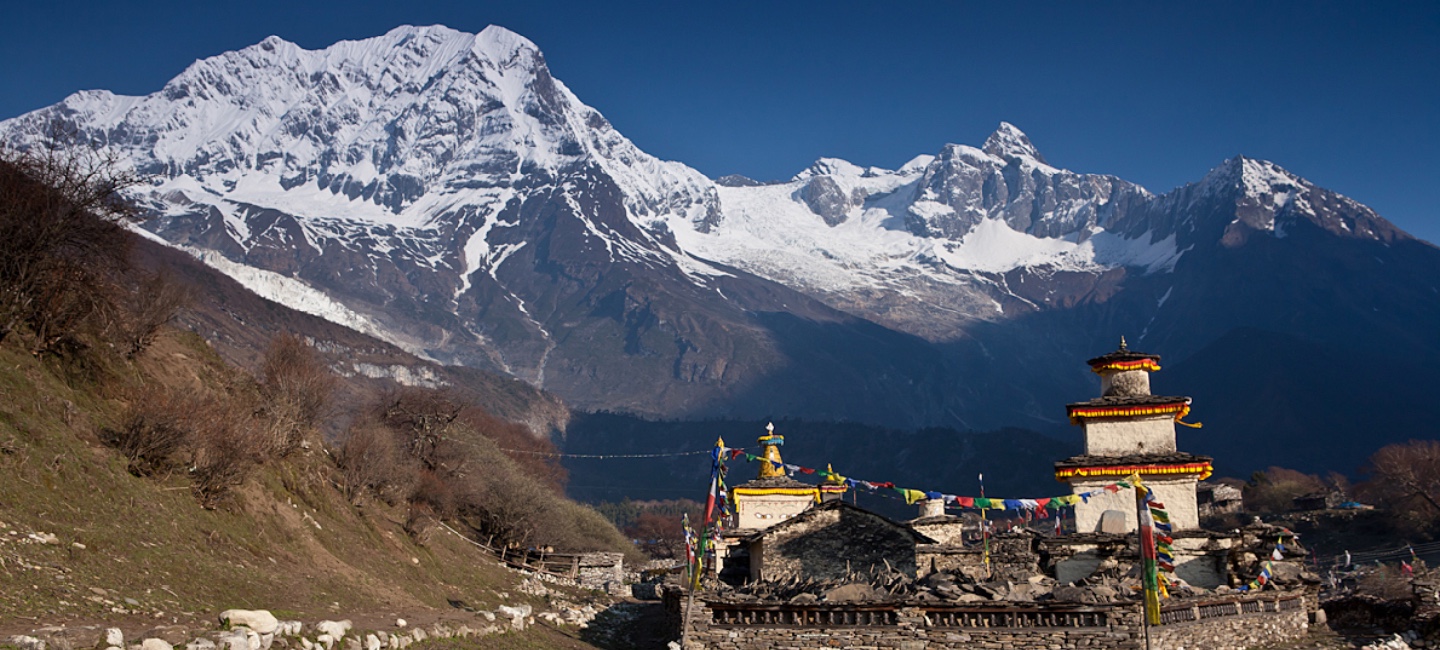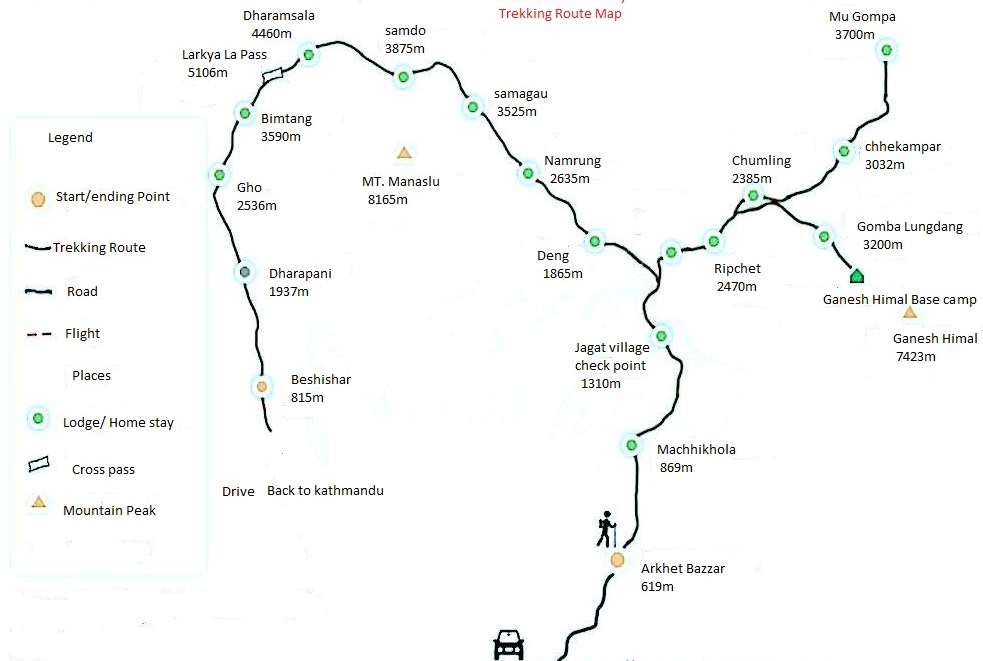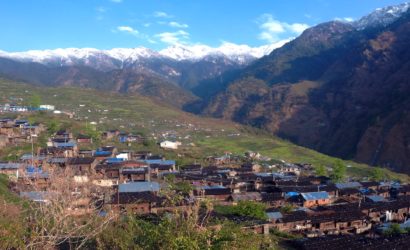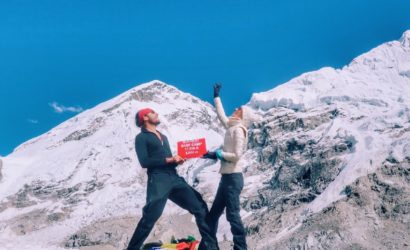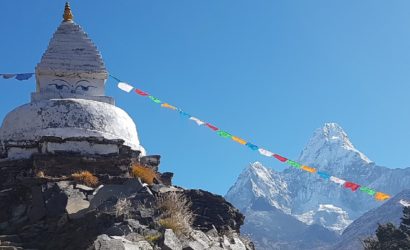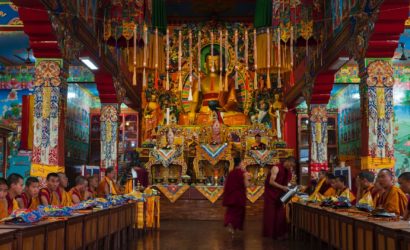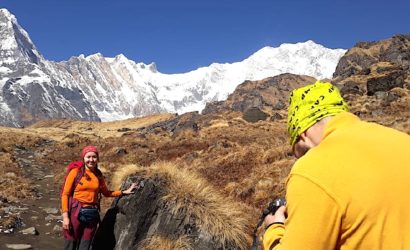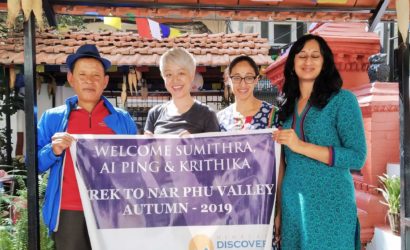The Tsum Valley is located east of Manaslu, on the Tibet border, home to the indigenous group known as Tsumbas. This isolated valley has only been opened as recently as 2008 to trekkers. It remains relatively untouched, waiting to be explored in ancient villages and Buddhist monasteries.
You will walk between 5–6 hours each day, with the high point of the trek 4,000 m above the valley’s largest monastery, Mu Gompa. On this trek, rather than in tents, you will be accommodated in lodges and traditional’ homestays.’ Since the Tsum Valley is very undeveloped, this accommodation* can be somewhat rudimentary and you can expect the local people to eat similar food (Dal Bhat, noodle soup, Chapatis). If you’re not prepared to rough it a bit, then this trek isn’t for you!
The Tsum Valley is situated in the Trans Himalayan region of Gorkha, Nepal and is renowned as a sacred Himalayan pilgrimage valley. Tsum’ comes from the Tibetan word ‘Tsombo’, which means vivid. The Tsum Valley is surrounded by the Boudha Himal and Himalchuli to the west, Ganesh Himal to the south & Sringi Himal to North.
The Tsum Valley is bounded by three high passes – the Ngula Dhoj Hyang (5,093 m.) to the west and Yamdro Pass (5,326m.) to the north. The local people of Tsum Valley are of Tibetan origin and practice Buddhist religion. The Tsum Valley Trekking starts at Arughat and the trail follows the winding Budi Gandaki River until it reaches the first elevated Tsum Valley with magnificent vistas of the Ganesh Himal and other surrounding peaks. Traditionally, Tsum valley was a culturally distinct geographical area called ‘Tsum Tso Chuksum’, which means thirteen provinces ruled as a single territory. Due to its remoteness and inaccessibility, this sacred valley and its people have been bypassed by mainstream development for centuries. As a result, the unique culture of this valley has remained intact.
Tsum Valley Trek: Highlights
- With only a few visitors, the Tsum Valley is relatively untouched and has its own unique culture
- Abundant wildlife, including herds of Himalayan blue sheep and wild mountain goats
- A Homestay/Teahouse trek-stay with the locals
- Prices include all permits for the Manalsu region and Tsum Valley
- Highly Experienced Sherpa trek guide
Upon your arrival in the Kathmandu airport after completing your custom formalities Visa, etc. pick up your luggage and look for our airport representative from Himalaya Discovery, who will display your name on the board at the arrival gate. You will be greeted by our representative and transferred to your hotel by private tourist vehicle. Overnight in Kathmandu.
Today is free for sightseeing in Kathmandu. You may wish to visit Durbar Square in the heart of the old city where the old Royal Palace, with its intricate woodcarving is located. The whole area is a maze of temples and images. Leading away from the square in all directions are narrow alleys, full of the most amazing variety of shops and stalls.
Some of these landmarks are considered World Heritage Sites including the historic Bhaktapur Durbar Square, the famous ‘Monkey Temple’ Swayambhunath and Buddhists shrine Buddhanath which is one of the largest Stupas in the world.
There will also be a full trip briefing today with gear check. In case you need to hire or buy equipment locally there will be time to do this today. Overnight at hotel in Kathmandu.
We take an 7-8 hrs bus ride to Arughat Bazaar in Gorkha district. The village of Arughat is in two parts, on opposite sides of the Buri Gandaki. Arughat Bazaar is large, clean and prosperous with hotels and shops selling cloth, food and hardware. Overnight at guesthouse.
From Arughat Bazar after breakfast we trek to Soti Khola. Along the way we enjoy splendid views of Shringri Himal. We trek through Gurung and Magar villages, past fields and cascading waterfalls, till we reach Soti Khola. We set up camp on the banks of the Soti Khola. Overnight at guesthouse.
We trek from Soti Khola to Machha khola (Fish river). Machha khola is a village situated above a stream with the same name. We camp for the night by a wide campsite. Overnight at guesthouse.
The trail from Macha Khola to Doban involves some steep ascents and descents. We climb a well-crafted staircase over a ridge to Doban. Doban lies at the confluence of the Shiar Khola, which flows from the east, and the Sarpu khola, which flows from the west, Overnight at guesthouse.
The route climbs ona rugged rocky trail. We climb up and down ravines and notched trees. We get good views of Sringri himal as we continue up to the village of Philim at 1590meters.This is a large Gurung village with fields of corn and millet. There are several good campsites and we set up camp surrounded by alder, blue pine and poplar trees, Overnight at tented camp.
We take the trail up through Philim and head up over a ridge that leads to Ganesh Himal Base camp and Chumling (Lower Tsum). We camp for the night at Chumling. There are several good campsites at Chumling, Overnight at guesthouse.
From Chumling we trek to Chhokangparo. Upper Tsum Valley (part of the Inner Himalaya) open from Chhokangparo.Chhekamparo is a village situated on flat land and made up of two settlements Chhekam and Paro.
From the valley, the Ganesh Himal range can be seen directly to the south where it provides spectacular views of the Baudha and Himal chuli peaks to the south-west, much more. Overnight at guesthouse.
From Chhokangparo we trek to Nile/ Chulle. This is the last village heading north in the upper Tsum Valley. Nile is on the western, sun-side of the Shiar Khola, about 20 minutes walk across from Chhule. On the way we pass the Piren Phu cave. Piren Phu (pigeon cave) is one of the most sacred caves in the Tsum valley. It is located at the foot of a rugged cliff near the village of Burji. Milarepa, the famous Tibetan saint, was believed to have meditated here.
There are two separate gumbas attached to the rocky cave. Richly painted Buddhist murals, excellent artistic scripts carved on stones, long prayer flags and significant Buddhists paper scripts make this cave one of the most important socio-cultural asset in the valley. Beautiful views can be had of the Shiar Khola, Rachen Gumba, the mountains and settlements amidst vast agricultural land, Overnight at guesthouse.
From Nile the trail gradually ascends to Mu gumba, the largest monastery in the region. Mu Gumba is located at the highest and farthest point in the Tsum valley. Mu Gumba was established in 1895 AD and is situated at an altitude of 3510m.
The monastery houses religious books, including Kangyur, a life sized statue of Avalokiteshwara, and images of Guru Padmasambhava and Tara. Dephyudonma Gumba is one of the oldest monasteries in the Tsum Valley and is situated in the rugged mountains, a 2 hr walk from the village of Chhule and Nile.
The history of this monastery is directly associated with the dawn of Buddhism in the valley. The monastery is run by Lama Serap of Nile Ladrang from the Kangin sect. There are a few campsites and dinking water facilities, overnight at guesthouse.
We are quite close to Tibet and get a good view of the Tibetan peaks as well as the Ganesh Himal range. After the day’s excursion we return to our camp at Mu gumba, overnight at guesthouse.
From Mu Gumba we take the trail to Rachen Gumba, a nunnery. The nunnery is situated in the Shiar Khola Valley in the foothills of the mountains bordering Nepal and Tibet. Rachen Gumba was established in the year 1905 AD and is one of the largest nunneries in the Tsum Valley.
It houses nuns belonging to the Ngak-pa sect, which does not allow animal slaughter. The nunnery houses one thousand clay, moulded statues of Avalokiteshwara, a brightly colored, carved throne and pillar, and a large prayer wheel. The interior is richly painted with murals about Buddhism and its history, overnight at tented camp.
From Rachen Gompa we proceed towards Dumje, a small village with about eight houses and adjoining cattle shed, overnight at guesthouse.
From Dumje we trek to Philim and cross Ripchet. On the way we pass one of the most beautiful waterfalls in the Lower Tsum Valley, Samba Tingding, Chhupyang, overnight at guesthouse.
From Phillim we trek to Tatopani. There is a hot spring at Tatopani. You can relieve your tired muscles by soaking yourself in the hot spring, overnight at guesthouse.
From Tatopani we trek to Soti Khola. We pass through terraced fields and tropical waterfalls and finally set up camp at the village, overnight at guesthouse.
As we make our way from Soti Khola to Arughat Bazar, we come to the last point of our journey, overnight at guesthouse.
The rest of the afternoon is free. Overnight in Kathmandu.
Today is rest and relax throughout the day. If you get interested to take some gifts from Nepal for friends and relatives, visit to some nearby shops or go out in Thamel for typical Nepalese goods which can be assisted by our guide or you can do it yourself too.
In the evening we will have a farewell dinner in a traditional Nepalese restaurant with cultural performances. Overnight in Kathmandu.
The trip ends, our airport representative will drop you to the airport for your flight departure from Nepal.

